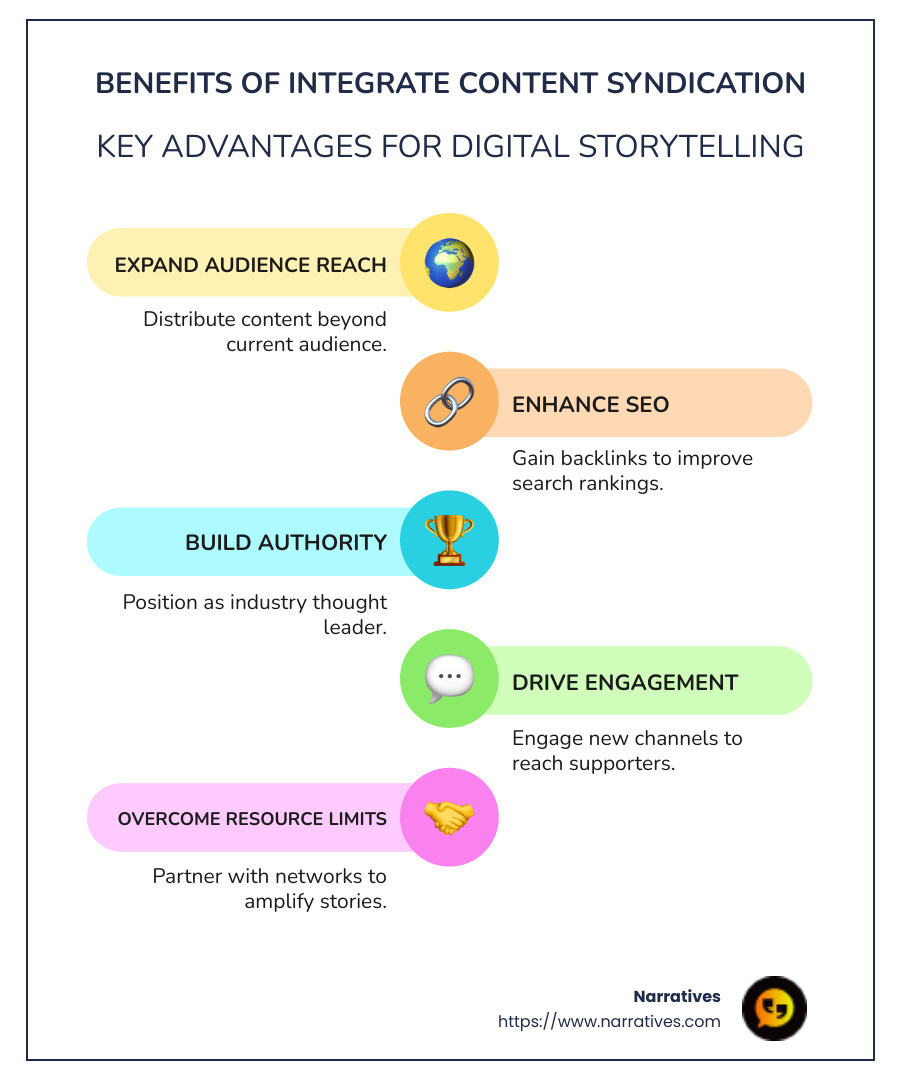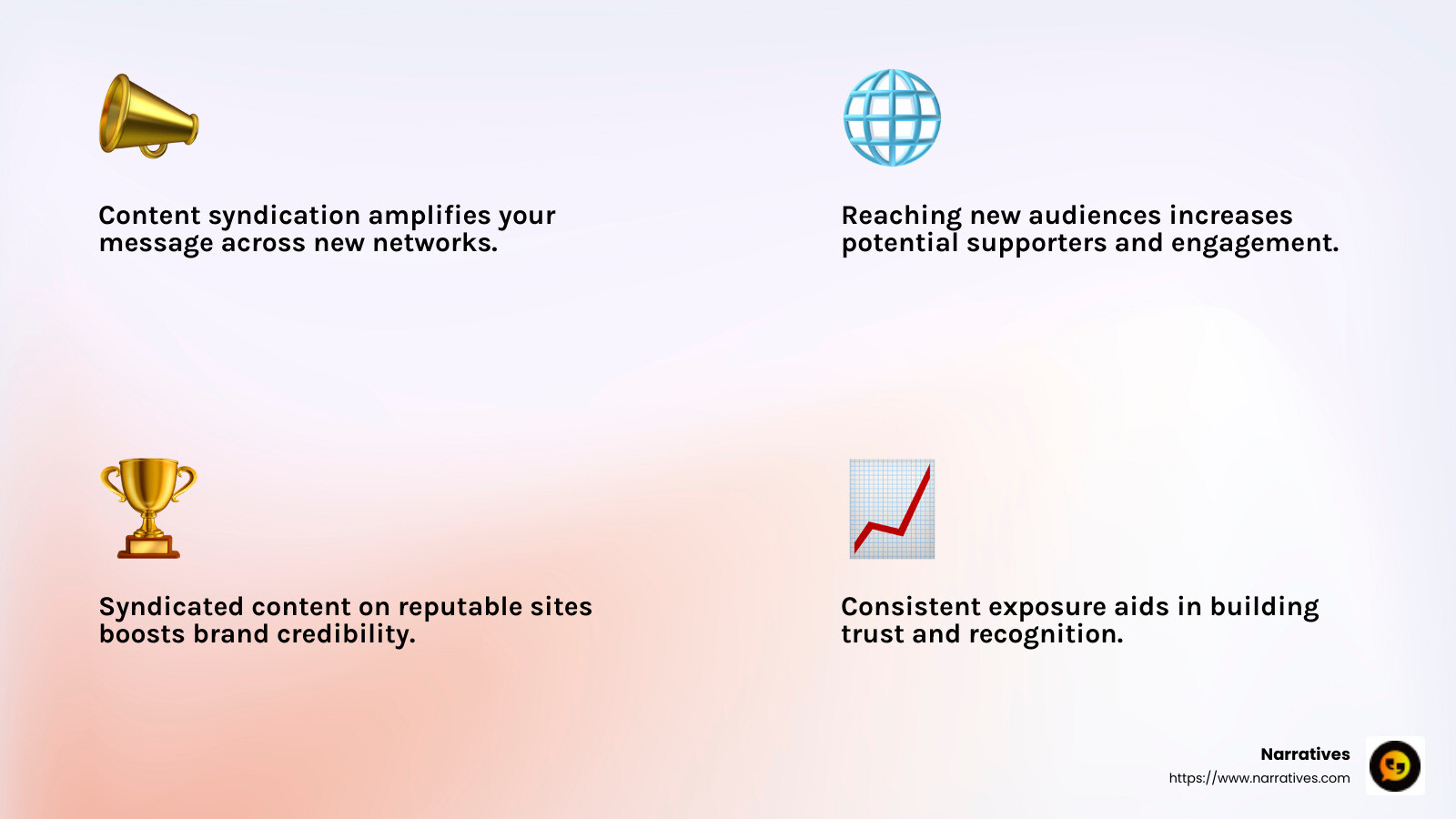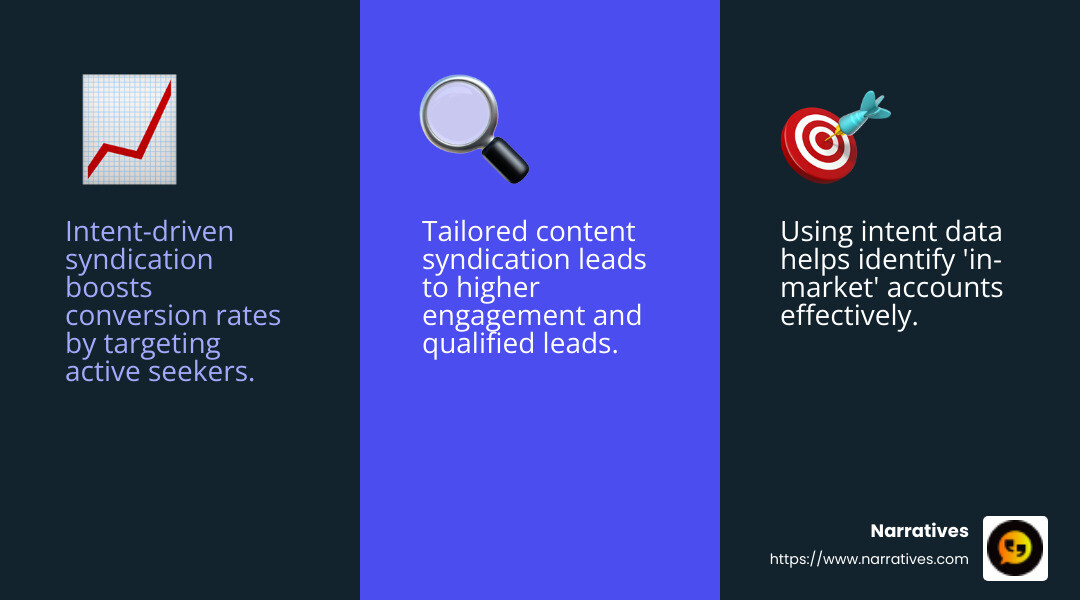Unlocking the Power of Content Syndication with Integrate

Integrate content syndication plays a pivotal role in boosting your organization's digital storytelling capabilities. If you are looking to extend the reach of your stories and amplify your impact, integrating content syndication can be a game-changer. Here's a quick snapshot of why it's valuable:
- Expand Audience Reach: Share your content beyond your current audience.
- Improve SEO: Gain backlinks that improve search engine rankings.
- Build Authority: Position yourself as an industry thought leader.
- Drive Engagement: Tap into new channels where your potential supporters are active.
In today's digital landscape, the ability to narrate compelling stories is crucial, especially for non-profits that aim to inspire action and drive social change. Content syndication is not just about rebroadcasting your content—it's about strategically placing your narratives where they will have the greatest impact.
By leveraging platforms like Integrate, you can tailor your storytelling efforts to your target audience, maximizing both engagement and return on investment. This integrated approach means your digital content can speak powerfully for your cause even when you're not actively promoting it.
With content syndication, you can overcome the challenges of limited resources and bandwidth. By partnering with trusted networks, you have the opportunity to authentically lift your story and further your mission.

Quick integrate content syndication definitions:
Understanding Content Syndication
Content syndication is like giving your stories a megaphone. It helps you share your message far and wide, reaching audiences you never thought possible. Let's break down how this works and why it's so powerful.
The Syndication Model
At its core, the syndication model involves sharing your content with other platforms or publishers. Think of it as lending your story to someone else's microphone. This model works wonders for expanding the reach of your content. You create something valuable, and syndication partners help you distribute it to their audiences.
This isn't just for large corporations. Non-profits and smaller organizations can also benefit from this approach by tapping into networks like Integrate. They provide a structured way to share your content with the right people at the right time.
Expanding Audience Reach
One of the biggest perks of content syndication is the ability to expand audience reach. When you syndicate your content, you're not just reaching your own followers. You're tapping into entirely new networks. This means more eyes on your content and more potential supporters for your cause.
Imagine your story being featured on high-traffic websites or popular social media channels. Suddenly, your message is in front of thousands, if not millions, of people who might have never heard of you before. This is the power of syndication.
Building Brand Recognition
Syndicating your content also helps in building brand recognition. When your content appears on reputable sites, it boosts your credibility. People start associating your name with quality content and thought leadership.
This is especially important for non-profits. Consistent exposure on well-known platforms can lift your organization's status, making it easier for you to gain trust and support from new audiences.

In summary, content syndication is a strategic tool to amplify your message. It leverages the reach of established platforms to bring your stories to a broader audience. This, in turn, builds recognition and trust, crucial elements for any organization looking to make a significant impact.
Next, we'll dive into how integrating content syndication with platforms like Integrate can further improve your storytelling strategy.
Integrate Content Syndication: A Strategic Approach
Content syndication can be a game-changer, especially when you apply a strategic approach with platforms like Narratives. Let's explore how intent-driven syndication, CRM integration, and demand acceleration can take your content strategy to the next level.
Intent-Driven Syndication
At the heart of effective syndication is the concept of intent-driven syndication. This approach focuses on sharing content with audiences who are actively seeking solutions or information in your niche. By using intent data, you can identify which accounts are "in market" and tailor your syndication efforts accordingly.

This means your content isn't just going out into the ether; it's reaching people who are already interested and more likely to engage. This strategy can significantly improve the quality of leads generated, making your marketing efforts more efficient and impactful.
CRM Integration
Integrating content syndication with Customer Relationship Management (CRM) systems is another powerful strategy. When your syndication efforts are aligned with your CRM, you ensure that every lead generated is tracked and nurtured appropriately. This alignment helps in creating a seamless flow from content engagement to lead conversion.
With platforms like Narratives, you can streamline this process by collecting and consolidating leads from various syndication channels into a single system. This not only saves time but also ensures data accuracy and compliance, which are critical for maintaining trust and efficiency in your marketing operations.
Demand Acceleration
Finally, demand acceleration is all about speeding up the journey from lead generation to sales conversion. By leveraging the capabilities of Narratives, you can quickly launch campaigns that target high-intent accounts. This means you can focus your resources on prospects who are most likely to convert, thus accelerating your demand generation efforts.
The use of intent data and CRM integration plays a crucial role here. By understanding where an account is in their buying journey, you can tailor your messaging and offers to move them through the funnel faster. This approach not only boosts your conversion rates but also maximizes your return on investment.
Narratives content syndication isn't just about spreading your message far and wide. It's about doing so strategically, reaching the right people at the right time, and driving real business results.
Next, let's explore the numerous benefits that content syndication offers to organizations looking to amplify their reach and impact.
Benefits of Content Syndication
Content syndication offers several powerful benefits that can amplify your organization's reach and impact. Let's explore how it expands your audience, boosts your site's authority, and improves brand recognition.
Larger Audience
One of the most significant advantages of content syndication is the ability to reach a larger audience. By distributing your content across various platforms, you tap into new segments of potential readers or viewers who may not have come across your content otherwise. This is especially beneficial for organizations like Narratives that aim to highlight underrepresented stories. By syndicating content, you can strategically target your Ideal Customer Profile (ICP) and engage with audiences who are already searching for content similar to yours.
Link Authority
Syndicating content can also improve your website's link authority. When your content appears on high-authority websites, it often includes backlinks to your site. These backlinks are valuable for improving your site's search engine optimization (SEO) rankings. Quality backlinks signal to search engines that your site is credible and trustworthy, which can boost your visibility in search results. This means more organic traffic and a higher likelihood of reaching your target audience effectively.
Brand Recognition
Finally, content syndication significantly boosts brand recognition. Consistently appearing on recognized and authoritative platforms positions your brand as a thought leader within your industry. As potential buyers or supporters see your brand repeatedly, they begin to associate it with expertise and trustworthiness. This increased exposure not only improves your reputation but also makes people more likely to engage with your content and, eventually, your products or services.
In summary, content syndication offers a strategic pathway to grow your audience, improve your site's authority, and establish your brand as a leader in your field. Next, we'll explore some common pitfalls to avoid when engaging in content syndication.
Common Pitfalls in Content Syndication
While content syndication can be a game-changer, there are several common pitfalls that can derail your efforts if not addressed. Let's look at some of these challenges and how to avoid them.
Wrong Audience
One of the biggest mistakes in integrate content syndication is targeting the wrong audience. Often, marketers cast too wide a net, hoping to catch as many eyes as possible. However, this can lead to wasted resources and unqualified leads.
To avoid this, it's crucial to develop detailed buyer personas. Understand your Ideal Customer Profile (ICP) and tailor your content to meet their specific needs and interests. This ensures that your content reaches those who are most likely to engage with it.
Incorrect Content Selection
Selecting the wrong content for syndication is another common misstep. Many think that promotional or product-centric content will drive leads, but this often backfires. Instead, focus on educational and value-driven content.
Avoid purely promotional content and choose pieces that educate and inform. Whether it's how-to guides or insights into industry trends, your content should aim to build trust and provide value to the reader.
Undefined Nurture Path
Without a defined nurture path, leads generated from syndication can quickly go cold. Many organizations fail to plan how they will engage and convert these leads post-syndication.
Create a clear follow-up strategy. This includes defining what constitutes a qualified lead and planning a compelling nurture path to guide them through the sales funnel. Collaboration with your sales team can help align expectations and ensure a seamless transition from interest to purchase.
By addressing these pitfalls, you can harness the full potential of content syndication, making it a powerful tool for reaching your goals. Next, we'll discuss best practices to ensure your syndication efforts are successful.
Best Practices for Successful Content Syndication
To make the most out of integrate content syndication, it's crucial to follow some best practices. These will help you target the right audience, provide valuable content, and personalize your approach for maximum impact.
Develop Detailed Buyer Personas
Creating detailed buyer personas is the first step in any successful content syndication strategy. These personas help you understand who your ideal customers are, what they care about, and how they make decisions.
Collect Data: Use insights from your sales and marketing teams to gather information about your audience. Look at demographics, job roles, challenges, and preferences.
Tailor Content: Once you know your audience, tailor your content to fit their needs. This ensures you are speaking directly to the people most likely to engage with your content.
Imagine a company that didn't define its buyer personas. They might end up targeting everyone, wasting resources on people who aren't interested in their offerings. By focusing on the right audience, you maximize your chances of success.
Focus on Educational Content
Educational content is the backbone of effective content syndication. It builds trust and establishes your brand as a thought leader.
Inform, Don't Sell: Avoid using promotional content. Instead, create how-to guides, industry insights, and trend analyses that provide real value to your audience.
Build Trust: Educational content helps establish credibility. When prospects trust your information, they're more likely to consider your products or services in the future.
Consider a scenario where a company uses product brochures in their syndication campaign. This approach often backfires, as it can come off as pushy. Instead, by focusing on educational content, you invite your audience to learn and engage without pressure.
Personalization and Verticalization
Personalization is key to making your content resonate with different segments of your audience. By tailoring your message to fit specific industries or job roles, you increase the relevance of your content.
Customize Content: Use multiple assets that address different aspects of your audience's challenges. For instance, a tech company might create different pieces for IT managers and software developers, each addressing their unique needs.
Segment Your Audience: Organize content by industry or job role so that each reader finds information relevant to them. This targeted approach improves engagement and conversion rates.
Think about a company that sends the same piece of content to all its prospects. This one-size-fits-all method often misses the mark. By personalizing content, you show your audience that you understand their specific needs and challenges.
By implementing these best practices, you can lift your content syndication efforts, ensuring that your content reaches the right people and delivers real value. Up next, we'll answer some frequently asked questions about content syndication to clear any lingering doubts.
Frequently Asked Questions about Content Syndication
What is content syndication?
Content syndication is a strategy where you distribute your content to third-party platforms to reach a broader audience. Think of it like sharing your blog post or article on a popular website. This way, more people get to see it, not just those who visit your site.
When you syndicate content, you're essentially extending the life and reach of your work. This helps in building brand awareness and authority. For example, when a piece of content is shared on a high-authority site, it can lead to valuable backlinks, boosting your website’s SEO.
How does content syndication benefit non-profits?
Non-profits often have powerful stories to tell but limited resources to share them. Content syndication can be a game-changer for these organizations.
Broader Reach: By sharing content on platforms with a large audience, non-profits can spread awareness about their cause more effectively. This is crucial for driving donations and support.
Building Authority: Syndicating content on reputable platforms helps establish non-profits as thought leaders in their field. This boosts credibility and trust among potential donors and volunteers.
Imagine a non-profit focused on environmental sustainability. By syndicating their success stories and impact reports on major news sites, they can inspire more people to join their cause.
What are common mistakes in content syndication?
While content syndication can be highly beneficial, there are common pitfalls to watch out for:
Wrong Audience: Not identifying your target audience is a frequent mistake. If your content isn't reaching the right people, it's unlikely to generate meaningful engagement.
Incorrect Content Selection: Not all content is suitable for syndication. For example, overly promotional pieces may not resonate with a broader audience. Instead, focus on educational or insightful content.
Undefined Nurture Path: Failing to define a follow-up strategy post-syndication can lead to missed opportunities. Once you've captured interest, have a clear plan for nurturing these leads.
By avoiding these pitfalls, you can maximize the impact of your integrate content syndication efforts. Up next, we will dive into some real-world examples of successful content syndication strategies.
Conclusion
As we wrap up our exploration of content syndication, it's clear that this strategy holds immense potential for non-profits. At Narratives, we understand the unique challenges faced by purpose-driven organizations, and we're committed to helping them open up the power of storytelling through integrate content syndication.
By partnering with non-profits, we aim to lift their voices and amplify their impact. Content syndication allows these organizations to reach wider audiences, share their stories, and inspire action. When non-profits effectively syndicate their content, they can build authority and foster trust, crucial elements for driving social change.
Imagine the social impact when a non-profit's story of change reaches millions. By sharing compelling narratives on high-authority platforms, non-profits not only increase visibility but also engage potential donors and volunteers. This ripple effect can lead to increased support and resources, furthering their missions.
At Narratives, we believe in the power of digital storytelling to transform communities. Our expertise in content syndication is designed to support non-profits in their journey to make a difference. By focusing on strategic partnerships and impactful stories, we help create a world where every voice is heard and every story matters.
Ready to lift your non-profit's storytelling? Learn more about how Narratives can help you make a lasting impact. Together, we can build a brighter future through the art of storytelling.


